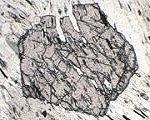Practical Aspects of Mineral Thermobarometry
Formula recalculation, including ferric iron estimation
Cations per formula unit
Although most microprobe software will calculate atomic proportions for you, it's quite likely that you'll want to recalculate analyses yourself.
The procedure for simple recalculation of a mineral analysis into cations per formula unit is given in Deer, Howie and Zussman (Appendix 1). The calculation is easy to set up in spreadsheet form. Have a go! When you've got it working, compare it with my own version, which is on the tools page as formula.xls.
For recalculating many analyses at one time, for generating database files which can be imported into spreadsheet programs, and for producing neat lists for including in reports, the old DOS program MINCALC may still have its uses.
Reference
W.A. Deer, R.A. Howie, J. Zussman (1992). An introduction to the rock-forming minerals, 2nd ed.. Longman Scientific & Technical, Harlow.
Ferric iron recalculation
Although the microprobe cannot distinguish between atoms of different valence states, it is possible in many cases to calculate the proportion of ferric iron required to satisfy charge balance.
If all the following can be reasonably assumed to be true:
- Fe is the only element present with variable valency
- Oxygen is the only anion
- The cation sites are full (no vacancies)
then F, the number of Fe3+ ions per X oxygens in the mineral formula, is given by
F = 2X.(1 - T/S)
where T is the ideal number of cations per formula unit, and S is the cation total obtained when all iron is assumed to be Fe2+.
Reference
Droop G.T.R. (1987) A general equation for estimating Fe3+ concentrations in ferromagnesian silicates and oxides from microprobe analyses, using stoichiometric criteria. Min. Mag. 51, 431-435.
This page last modified 12 October 2004
